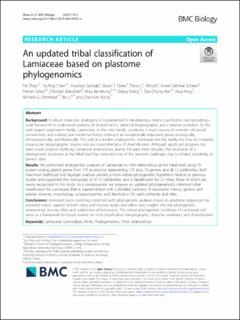| dc.contributor.author | Zhao, Fei | |
| dc.contributor.author | Chen, Ya-Ping | |
| dc.contributor.author | Salmaki, Yasaman | |
| dc.contributor.author | Drew, Bryan T. | |
| dc.contributor.author | Wilson, Trevor C. | |
| dc.contributor.author | Scheen, Anne-Cathrine | |
| dc.contributor.author | Celep, Ferhat | |
| dc.contributor.author | Bräuchler, Christian | |
| dc.contributor.author | Bendiksby, Mika | |
| dc.contributor.author | Wang, Qiang | |
| dc.contributor.author | Min, Dao-Zhang | |
| dc.contributor.author | Peng, Hua | |
| dc.contributor.author | Olmstead, Richard G. | |
| dc.contributor.author | Li, Bo | |
| dc.contributor.author | Xiang, Chun-Lei | |
| dc.date.accessioned | 2021-01-22T14:47:13Z | |
| dc.date.available | 2021-01-22T14:47:13Z | |
| dc.date.created | 2021-01-21T10:02:21Z | |
| dc.date.issued | 2021 | |
| dc.identifier.citation | BMC Biology. 2021, 19 (2), 1-27. | en_US |
| dc.identifier.issn | 1741-7007 | |
| dc.identifier.uri | https://hdl.handle.net/11250/2724325 | |
| dc.description.abstract | Background
A robust molecular phylogeny is fundamental for developing a stable classification and providing a solid framework to understand patterns of diversification, historical biogeography, and character evolution. As the sixth largest angiosperm family, Lamiaceae, or the mint family, consitutes a major source of aromatic oil, wood, ornamentals, and culinary and medicinal herbs, making it an exceptionally important group ecologically, ethnobotanically, and floristically. The lack of a reliable phylogenetic framework for this family has thus far hindered broad-scale biogeographic studies and our comprehension of diversification. Although significant progress has been made towards clarifying Lamiaceae relationships during the past three decades, the resolution of a phylogenetic backbone at the tribal level has remained one of the greatest challenges due to limited availability of genetic data.
Results
We performed phylogenetic analyses of Lamiaceae to infer relationships at the tribal level using 79 protein-coding plastid genes from 175 accessions representing 170 taxa, 79 genera, and all 12 subfamilies. Both maximum likelihood and Bayesian analyses yielded a more robust phylogenetic hypothesis relative to previous studies and supported the monophyly of all 12 subfamilies, and a classification for 22 tribes, three of which are newly recognized in this study. As a consequence, we propose an updated phylogenetically informed tribal classification for Lamiaceae that is supplemented with a detailed summary of taxonomic history, generic and species diversity, morphology, synapomorphies, and distribution for each subfamily and tribe.
Conclusions
Increased taxon sampling conjoined with phylogenetic analyses based on plastome sequences has provided robust support at both deep and shallow nodes and offers new insights into the phylogenetic relationships among tribes and subfamilies of Lamiaceae. This robust phylogenetic backbone of Lamiaceae will serve as a framework for future studies on mint classification, biogeography, character evolution, and diversification. | en_US |
| dc.language.iso | eng | en_US |
| dc.publisher | BioMed Central | en_US |
| dc.rights | Navngivelse 4.0 Internasjonal | * |
| dc.rights.uri | http://creativecommons.org/licenses/by/4.0/deed.no | * |
| dc.title | An updated tribal classification of Lamiaceae based on plastome phylogenomics | en_US |
| dc.type | Peer reviewed | en_US |
| dc.type | Journal article | en_US |
| dc.description.version | publishedVersion | en_US |
| dc.source.pagenumber | 1-27 | en_US |
| dc.source.volume | 19 | en_US |
| dc.source.journal | BMC Biology | en_US |
| dc.source.issue | 2 | en_US |
| dc.identifier.doi | 10.1186/s12915-020-00931-z | |
| dc.identifier.cristin | 1876271 | |
| dc.description.localcode | This article is licensed under a Creative Commons Attribution 4.0 International License, which permits use, sharing, adaptation, distribution and reproduction in any medium or format, as long as you give appropriate credit to the original author(s) and the source, provide a link to the Creative Commons licence, and indicate if changes were made. The images or other third party material in this article are included in the article's Creative Commons licence, unless indicated otherwise in a credit line to the material. If material is not included in the article's Creative Commons licence and your intended use is not permitted by statutory regulation or exceeds the permitted use, you will need to obtain permission directly from the copyright holder. To view a copy of this licence, visit http://creativecommons.org/licenses/by/4.0/. The Creative Commons Public Domain Dedication waiver (http://creativecommons.org/publicdomain/zero/1.0/) applies to the data made available in this article, unless otherwise stated in a credit line to the data. | en_US |
| cristin.ispublished | true | |
| cristin.fulltext | original | |
| cristin.qualitycode | 2 | |

